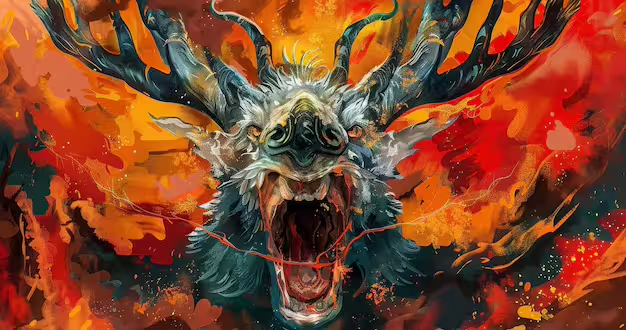The Fire Kirin, a legendary creature originating from East Asian mythology, has captivated the imaginations of many due to its enchanting beauty and powerful symbolism. Often depicted as a divine being that brings good fortune and protection, the Fire Kirin stands out as one of the most revered mythical creatures. This guide will delve into the fascinating world of the Fire Kirin, exploring its origins, symbolism, physical attributes, cultural significance, and how it continues to influence modern storytelling and art.
Table of Contents
- Understanding the Fire Kirin
- Origins and Mythology of the Fire Kirin
- Symbolism of the Fire Kirin
- Physical Attributes and Characteristics
- The Fire Kirin in Cultural Context
- The Fire Kirin in Modern Culture
1. Understanding the Fire Kirin
The Fire Kirin, known as “Huo Qilin” in Chinese, is a mythical creature often associated with prosperity, good fortune, and protection from evil spirits. It is a hybrid creature that shares characteristics with the horse, dragon, and deer, embodying qualities that evoke power, grace, and wisdom. While it resembles the traditional Kirin, which is often depicted as a hooved creature with a dragon-like appearance, the Fire Kirin specifically symbolizes the element of fire, adding an additional layer of meaning to its existence.
In various cultures, the Fire Kirin serves as a guardian and a bringer of good luck, often appearing during significant events or the birth of important figures. Its presence is thought to signify prosperity and a harmonious relationship between humanity and nature.
2. Origins and Mythology of the Fire Kirin
The origins of the Fire Kirin can be traced back to ancient Chinese mythology, where it is often mentioned alongside other legendary creatures such as dragons and phoenixes. The concept of the Kirin itself dates back over 2,000 years, with references found in texts such as the “Shan Hai Jing” (Classic of Mountains and Seas). According to these ancient texts, the Kirin appeared during significant events, including the birth of wise rulers or the passing of great sages.
Over time, the Fire Kirin evolved into a distinct entity, often depicted with flames and a fiery mane, representing its elemental association with fire. In folklore, the Fire Kirin is said to appear only during times of great peace and prosperity, symbolizing the harmonious balance between nature and humanity. Its appearance was considered an omen of great fortune, and many sought to capture its image or essence for protection and blessings.
3. Symbolism of the Fire Kirin
The Fire Kirin is rich in symbolism, representing various themes that resonate across cultures. Primarily, it embodies the following concepts:
A. Good Fortune and Prosperity
The Fire Kirin is often seen as a harbinger of good luck and success. In many cultures, people believe that having images or statues of the Fire Kirin can attract positive energy and wealth.
B. Protection Against Evil
Another significant aspect of the Fire Kirin’s symbolism is its role as a protector. It is believed to ward off evil spirits and negative influences, providing a sense of safety and security to those who revere it.
C. Harmony and Balance
The Kirin represents the delicate balance between different forces in nature. Its association with both fire and nature highlights the interconnectedness of life and the importance of living in harmony with one’s environment.
D. Wisdom and Knowledge
In many legends, the Kirin is associated with wisdom and enlightenment. It often appears as a guide, leading those who seek knowledge and understanding along their journeys.
4. Physical Attributes and Characteristics
The Kirin possesses distinct physical characteristics that set it apart from other mythical creatures. These attributes contribute to its majestic and awe-inspiring presence:
A. Fiery Appearance
The most notable feature of the Kirin is its fiery mane and tail, which are often depicted as flowing flames. This visual representation reinforces its connection to the element of fire.
B. Hybrid Form
The Kirin typically embodies a blend of various animal features. It often has the body of a horse, the scales of a dragon, and the hooves of a deer. This unique combination of traits emphasizes its mystical nature.
C. Ornate Antlers
The Fire Kirin is often illustrated with elegant antlers, reminiscent of those found on deer. These antlers symbolize its connection to nature and its role as a guardian of the forest.
D. Bright Colors
Artists frequently portray the Fire Kirin in vibrant colors, including reds, oranges, and golds. These colors not only represent fire but also signify energy, vitality, and life.
5. The Fire Kirin in Cultural Context
Throughout history, the Kirin has held a prominent place in East Asian culture. It appears in various forms of art, literature, and religious practices, influencing the perception of mythical creatures and their significance.
A. Art and Literature
The Kirin has inspired countless artists and writers, appearing in paintings, sculptures, and literary works. Its portrayal often reflects cultural values, emphasizing the themes of wisdom, protection, and harmony.
B. Festivals and Celebrations
In some regions, festivals and celebrations honor the Kirin, showcasing its importance in local traditions. These events often feature parades, performances, and artistic displays that celebrate the mythical creature and its symbolism.
C. Religious Significance
It serves as a symbol of divine intervention and protection, embodying the qualities that believers seek in their spiritual journeys.
6. The Fire Kirin in Modern Culture
In contemporary society, the Kirin continues to capture the imagination of artists, filmmakers, and game developers. Its enduring legacy is evident in various forms of entertainment and popular culture:
A. Movies and Television
The Kirin has made appearances in films and television shows that draw upon East Asian mythology. Its portrayal often emphasizes its mystical qualities and powerful symbolism.
B. Video Games
Many video games incorporate the Kirin as a character or a symbol within their narratives. Its unique attributes and abilities make it a popular choice for game designers seeking to create engaging and fantastical worlds.
C. Merchandise and Collectibles
The Fire Kirin’s popularity has led to the creation of various merchandise items, including toys, collectibles, and home decor. Fans of mythology often seek out these items to celebrate their admiration for the legendary creature.
Conclusion
The Kirin stands as a symbol of good fortune, protection, and harmony in East Asian mythology. Its captivating physical attributes and rich cultural significance make it an enduring figure in art, literature, and modern storytelling. As we continue to explore and celebrate the Kirin, we acknowledge its role as a guardian and a bringer of prosperity, bridging the gap between ancient beliefs and contemporary culture.
By understanding the Fire Kirin’s origins, symbolism, and modern adaptations, we can appreciate its influence on both historical and current narratives, ensuring that this legendary creature remains a beloved figure for generations to come.
Are you passionate about sharing your insights and expertise? We invite you to write for us! Whether you’re a seasoned writer or just starting out. We’re looking for fresh perspectives on a variety of topics, from lifestyle and wellness to technology and travel.
Are you passionate about sharing your insights and expertise? We invite you to write for us! Whether you’re a seasoned writer or just starting out. We’re looking for fresh perspectives on a variety of topics, from lifestyle and wellness to technology and travel.
 Lifeyet News Lifeyet News
Lifeyet News Lifeyet News





